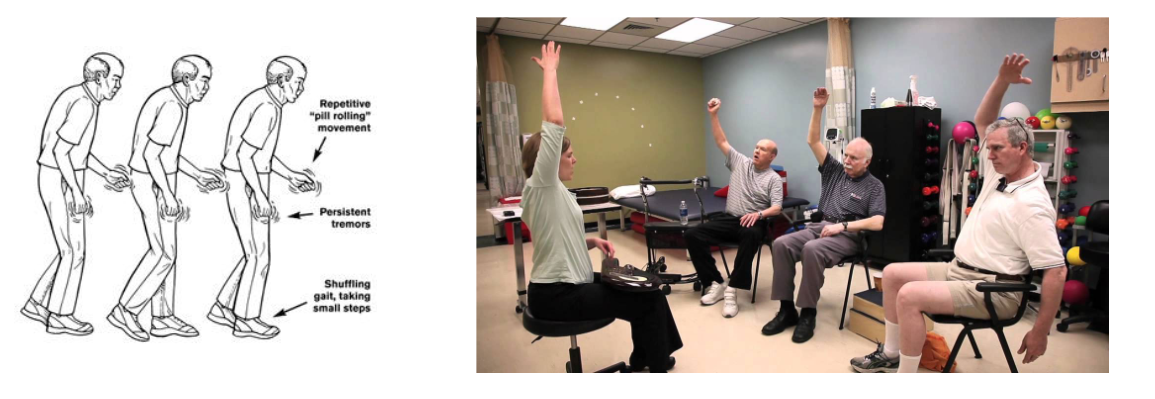Chapter 10 - Audition (copy)
1/48
There's no tags or description
Looks like no tags are added yet.
Name | Mastery | Learn | Test | Matching | Spaced |
|---|
No study sessions yet.
49 Terms
When does sound occur?
When air is brought into vibration → leading to compression of air molecules that propagate as a wave.
NB: like vision, what we experience as sound is a construct of our brain.
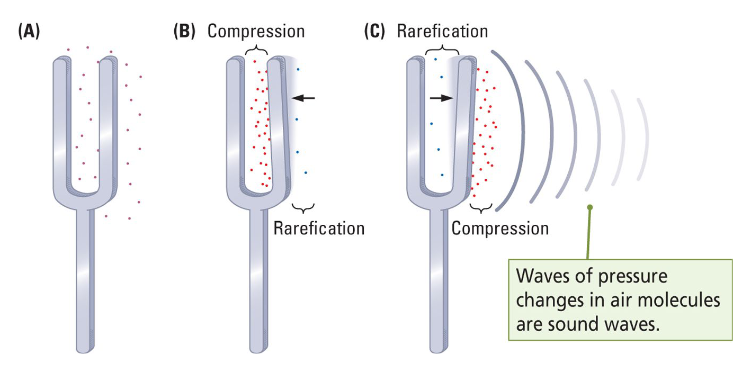
What is Compression?
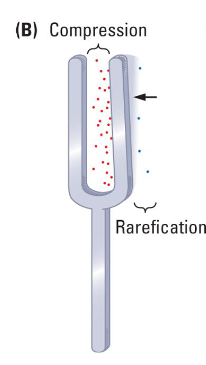
What is Rarefication?

What does sound travel through?
Through a compressible medium (e.g. air, water, ground).
What are the 3 properties of Sound waves? What are they perceived as?
Frequency
Measured in Hertz (Hz; vibrations per second).
Perceived as pitch.
Amplitude
Measured in decibels (dB; relative strength).
Perceived as loudness.
Complexity
Most sounds are a combination of different frequencies and amplitudes.
Perceived as timbre.

What is the Human hearing range in frequency?
20 to 20000Hz.
What is the maximum frequency by age?
(I don’t think you have to know this by heart though).
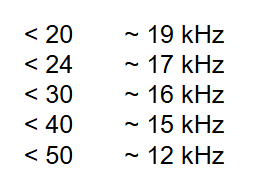
What is Frequency and pitch perception?
The rate at which sound waves vibrate is measured as cycles per second, or Hertz (Hz).
Low frequency = long distance (e.g. whales)
low-pitched sound
High frequency = echo (sonar; bats, dolphins)
high pitched sound
Pitch contributes to the perceived melodic tone of a voice or prosody.

What is Amplitude used to measure for?
Loudness; intensity of sound is usually measured in decibels (dB).
Prolonged exposure to sounds > 100 dB likely leads to hearing damage.
NB: Doubling the perceived loudness corresponds to a 3 dB increase.

What is a Fundamental frequency?
Rate at which the complex waveform pattern repeats (e.g. 100 Hz).
What are Overtones?
Most sounds have multiple overtone = higher-frequency sound waves that vibrate at whole-number multiples of the fundamental frequency (e.g. 200, 300, 400 Hz, etc.).
The relative strength of the overtones will determine the timbre (‘color’) of the sound (e.g. violin, piano, etc.).
What is a key feature of Complex tones?
Periodicity: the fundamental frequency repeats at regular intervals. Sounds that are aperiodic = noise.

What does the Functional anatomy of the Auditory system consist of?
Outer ear
Pinnal/Auricle
External ear canal
Eardrum
Middle ear (the ossicles)
Hammer/Malleus
Anvil/Incus
Stirrup./Stapes
Inner ear
Oval window
Round window
Cochlea
Organ of Corti
Auditory nerve
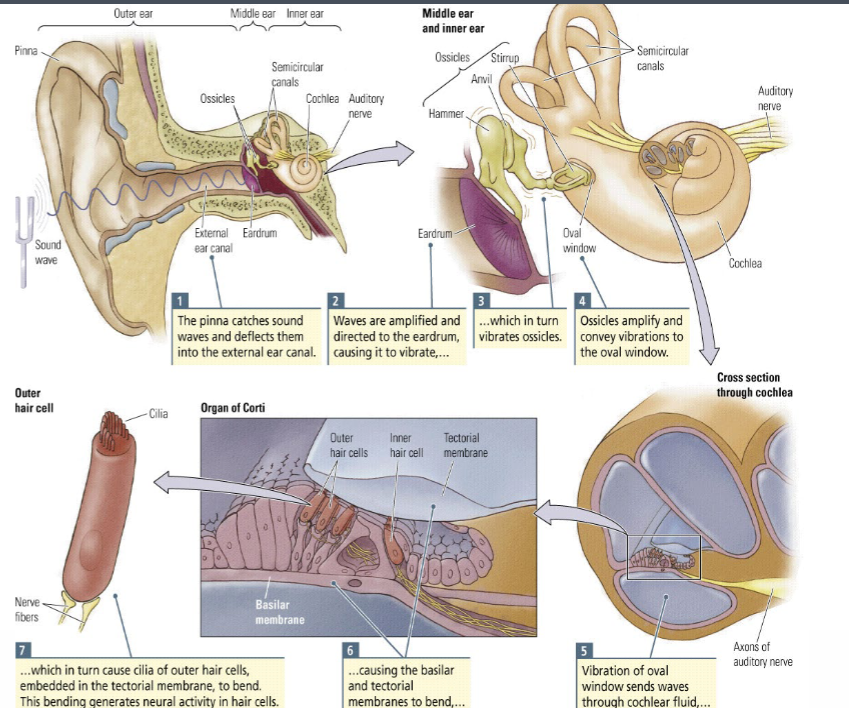
What parts does the Outer ear consist of?
Pinna/Auricle
External ear canal
Eardrum ‘tympanic membrane’
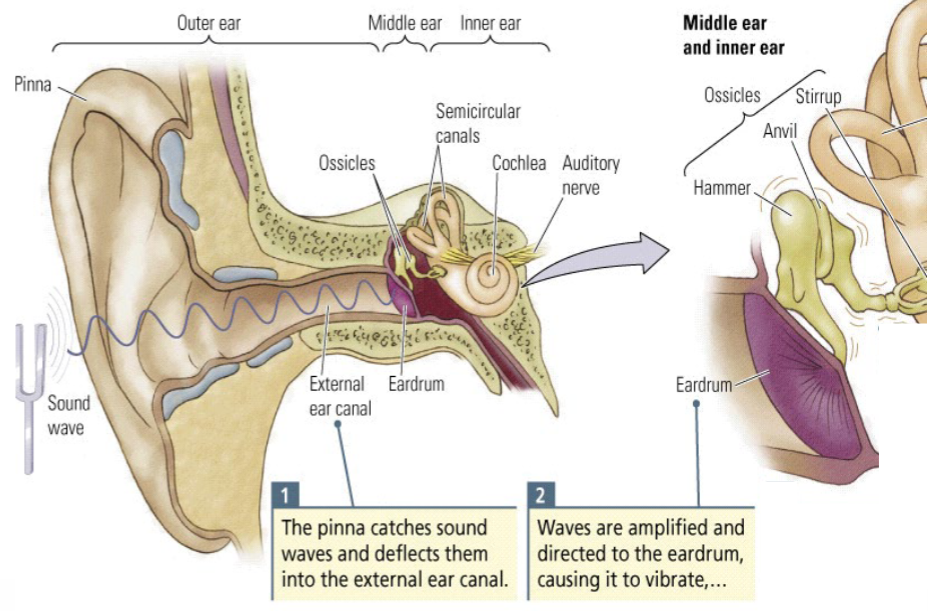
What parts does the Middle ear consist of?
Ossicles:
Hammer/Malleus
Anvil/Incus
Stirrup/Stapes

What parts does the Inner ear consist of?
Oval window
Round window
Cochlea
Organ of Corti
Auditory nerve
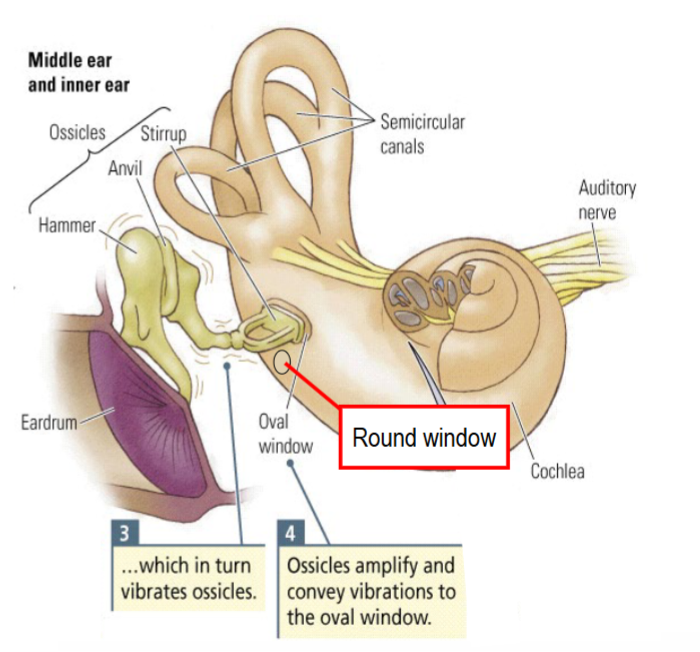
What are the 8 steps in which Sound travels through the ear?
The Pinna catches sound waves and deflects them into the external ear canal.
Waves are amplified and directed to the eardrum, causing it to vibrate,
which in turn vibrates ossicles.
Ossicles amplify and convey vibrations to the oval window.
Vibration of oval window sends waves through cochlear fluid,
causing the basilar and tectorial membranes to bend,
which in turn cause cilia of outer hair cells, embedded in the tectorial membrane, to bend.
This bending generates neural activity in cells.
What is the difference between Outer hair cells and Inner hair cells?
Outer hair cells (~12000)
Connected to tectorial membrane
NOT receptors; only influence the stiffness of the tectorial membrane → motor function (base = stiff; apex = fluffy).
Inner hair cells (~3500, way less)
NOT connected to the tectorial membrane, only make loosely contact.
Auditory receptors
Do NOT regenerate (damage → permanent hearing loss).
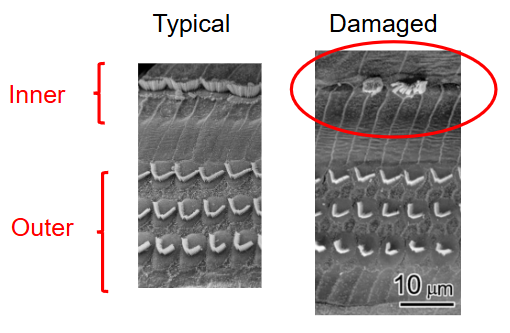
What happens in the Organ of Corti?
Vibration of the oval window sends waves through the cochlear fluid,
Causing the basilar and tectorial membranes to vibrate,
And the cochlear fluid to flow past the cilia of the inner hair cells,
Which in turn cause the cilia to bend.
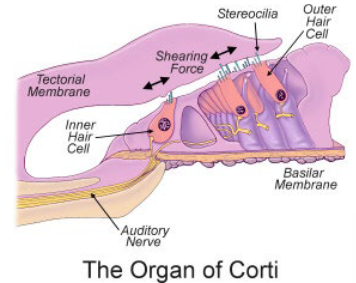
What is the Auditory nerve formed by?
The axons of the inner hair cells form the auditory nerve.
Inner hair cells continuously leak calcium; what are the consequences of this?
Small but steady amount of neurotransmitter release into the synapse (i.e. spontaneous baseline firing rate).
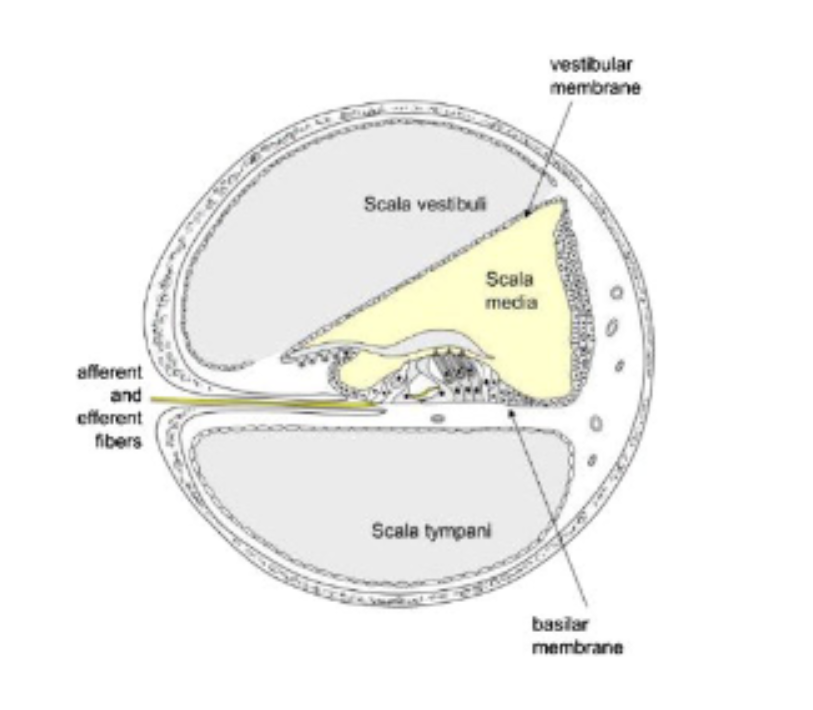
What happens when there is movement of the cilia?
Movement of the cilia changes the inner hair cell’s membrane polarization and its rate of neurotransmitter release (see also ch4, 5).
Movement in one direction results in Depolarozation: K+ influx → Ca2+ influx → more neurotransmitter in synaptic cleft (excitation).
Movement in the other direction results in Hyperpolarization: K+ efflux → less neurotransmitter in synaptic cleft (inhibition).
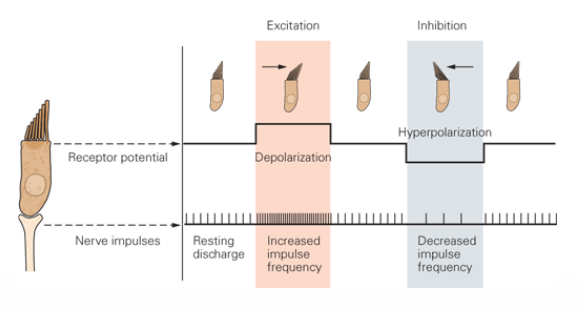
What does the Pathway to the Auditory Cortex look like?
(notes from the book)
Auditory input cross to the hemisphere opposite the ear in the hindbrain and midbrain.
Then recross in the thalamus.
In this way, the information from each ear reaches both hemispheres.
Multiple nuclei process inputs en route to the auditory cortex, charted here for the left ear.
You DON’T need to know the exact names of the crossings, only the components.
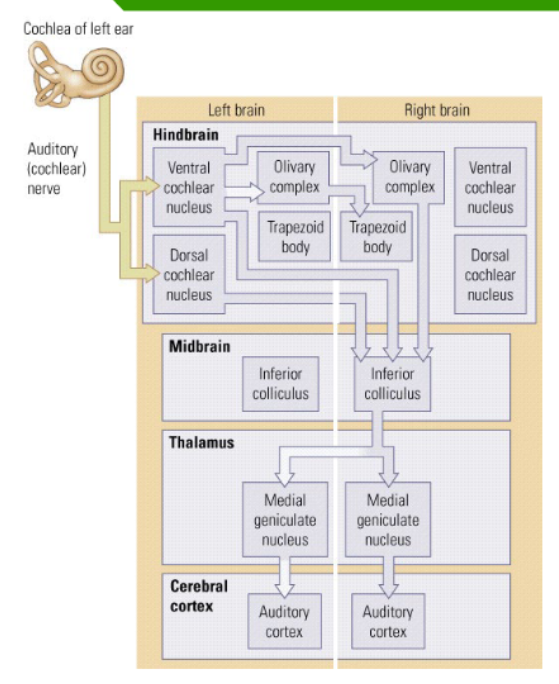
What is the Pathway to the Auditory Cortex?
Cochlea of left ear
Auditory information leave through the auditory nerve.
Hindbrain
Superior olivary nucleus
Trapezoid body
Midbrain
Inferior colliculus (receives auditory information)
Diencephalon
Auditory input
Processed on the Medial geniculate nucleus to auditory cortex.
Cerebral cortex
Auditory cortex
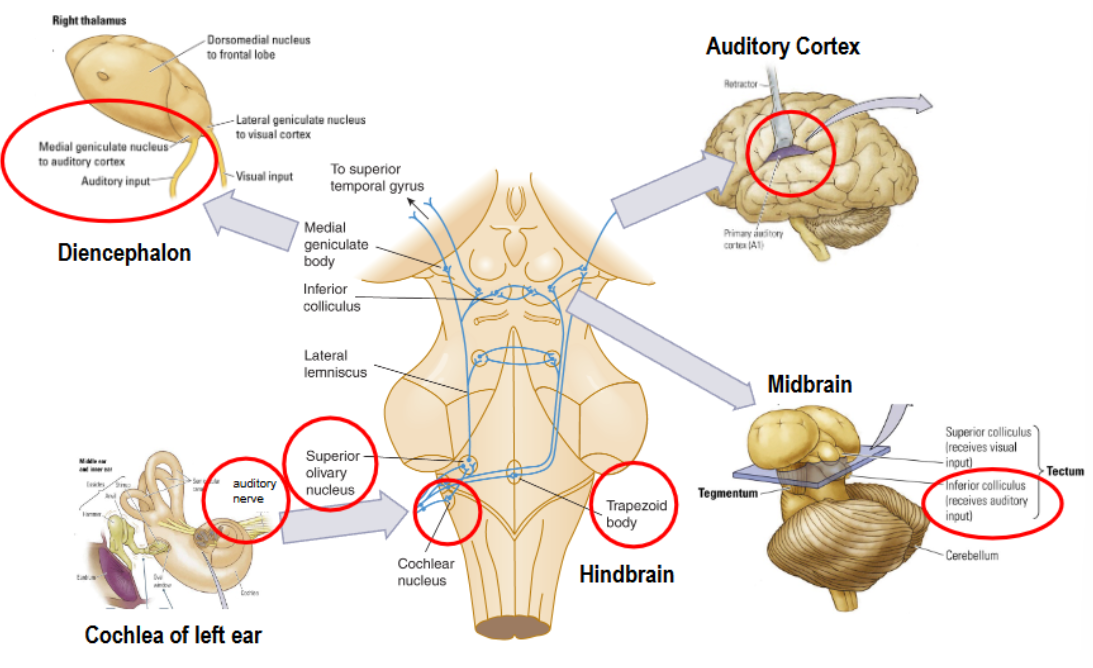
What are projections from the auditory nerve connected with?
Projections from the auditory nerve connect with contralateral and ipsilateral nuclei.
Inputs from the two ears are mixed to form a single auditory perception.
What part of the Cortex is involved in Audition?
Primary auditory cortex (A1, Heschl’s gyrus)/
Secondary auditory cortex (A2)
A2 area behind A1 = planum temporale
What is the Planum temporale?
The A2 Area behind A1.
What does Lateralization for right-handed individuals look like?
note: Lateralization describes the concept that some brain functions are specialized to either the right or left side of the human brain.
In RIGHT hemisphere, Heschl’s gyrus = larger
Analyzing music
In LEFT hemisphere, planum temporale = larger
Wernicke’s area, speech comprehension
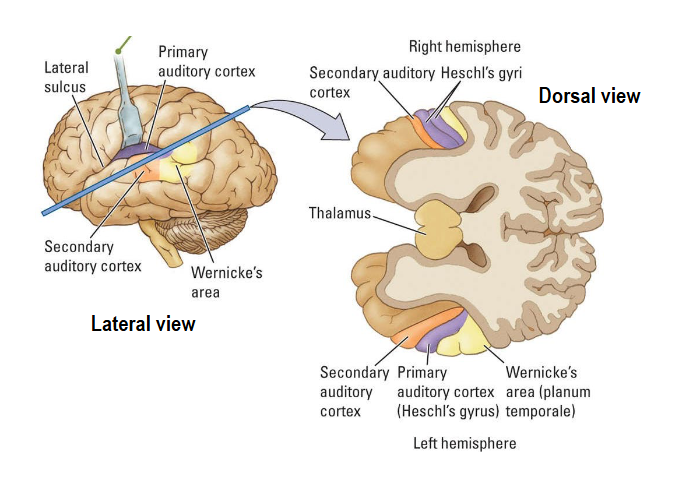
How is the Wernicke’s area divided for left-handed individuals?
70% in left hemisphere (typical)
15% in right hemisphere (inversed)
15% in both left and right hemisphere (bilateral)
How does Coding of frequency (pitch) happen?
Hair cells in the cochlea code frequency as a function of their location on the basilar membrane.
Tonotopic organization = example of spatial coding.
How are frequencies picked up in the cochlea?
At the base (beginning) of the cochlea
basilar membrane is narrow, thick and stiff.
here the hair cells respond primarily to high frequencies (up to 20000 Hz).
At the apex (end) of the cochlea
basilar membrane is wide, thin and soft.
here the hair cells respond primarily to low frequencies (from 20 Hz upwards).

What notion has led to the development of cochlear implants?
The finding that the tonotopic representation of frequency is maintained throughout auditory pathways into A1.
How are sounds below 200 Hz coded?
Sounds below 200 Hz are not coded tonotopically, but temporally.
i.e. sound frequency = membrane frequency = firing rate of neurons F0 speech 85-180 Hz (male), 165 to 255 Hz (female, children).

What 6 things does Larger amplitude of the sound wave lead to?
More intense vibrations of the oval window
More intense waves in the cochlear fluid
More intense vibration of basilar and tectorial membranes
More intense cochlear fluid flow past the cilia of the inner hair cells
More release of neurotransmitter
Bipolar neurons fire more frequently
Example of temporal coding.
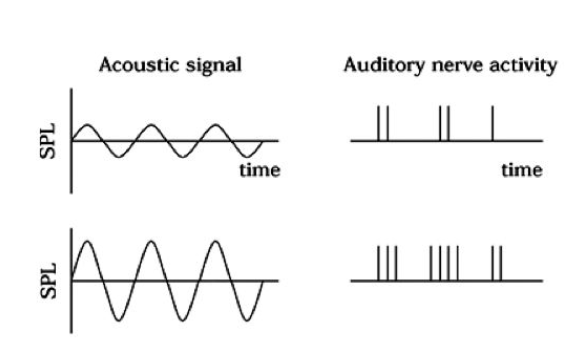
What are the 2 ways in which we Code location in audition? Where are these processes computed?
Based on the difference between the two ears in:
Arrival time = Interaural time difference (ITD)
detection threshold in humans ~10μs
computed in medial superior olivary complex
Loudness = Interaural intensity difference (IID)
computed in lateral superior olivary complex and trapezoid body
most effective for high frequencies (head shadow).

Humans use ITD and IID to localize sounds in the [horizontal / vertical] plane.
Horizontal.
Locating sound front vs. back, above us vs. below us, requires head tilting / turning.
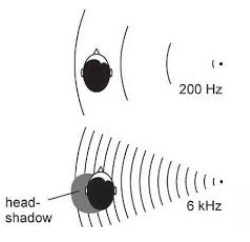
What is the role of the Pinna in localizing sounds?
Pinna provide monaural cues that help localize sounds in the vertical plane (but not as accurately as e.g. owls).
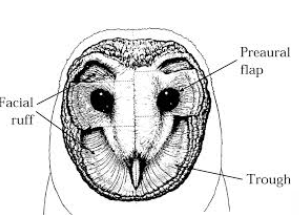
What role do the Ventral and Dorsal area of the brain have in Localizing language in the brain?
Ventral: auditory object recognition.
Understanding language
Dorsal: audition for action.
Producing language
Where is the Wernicke’s area located?
Left temporal lobe.
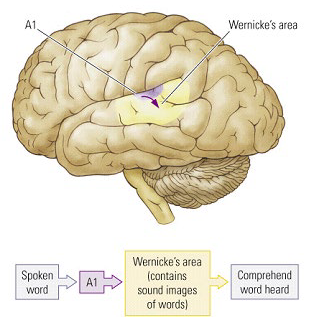
What is Wernicke’s aphasia?
Fluent speech, but incoherent, no speech comprehension.
Where is the Broca’s area located?
Left frontal lobe.
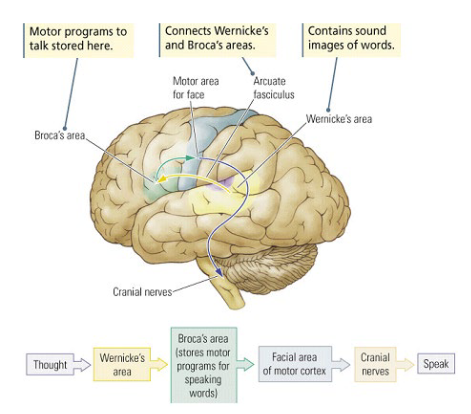
What is Broca’s aphasia?
Non-fluent speech, but intact speech comprehension.
Language processing occurs exclusively in the left hemisphere. Is this true or false?
False; language processing does not occur exclusively in the left hemisphere.
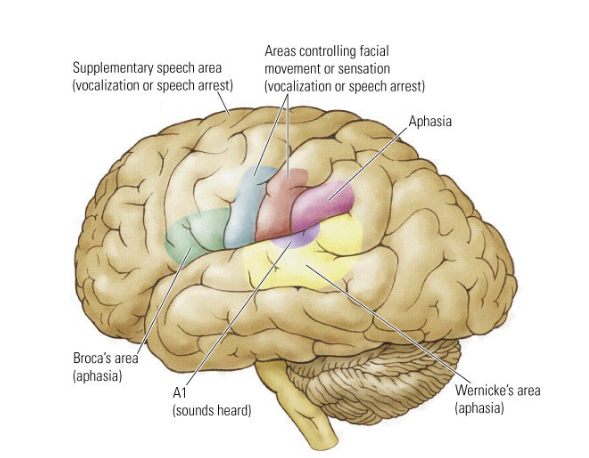
Why can we use PET to localize language in the brain?
Left-right hemisphere differences are relative, not absolute (i.e. activation in both hemispheres).

Why is Broca’s area in speech discrimination?
Comprehension of some speech sounds requires articulatory knowledge.
Where is Music localized in the brain?
The organization of music is similar to that of language, but lateralized to the right hemisphere instead of the left hemisphere.
Music processing does not occur exclusively in the right hemisphere.

Which areas in the brain correspond to the following:
Listening to bursts of music
Listening to melodies
Comparing pitches
Listening to bursts of noise = Area A1
Listening to melodies = Area A2
Comparing pitches = Frontal lobe (short-term memory)

What do the following areas do with regard to Localizing music in the brain?
Area A1
Area A2
Frontal lobe (short-term memory)
Area A1 = Listening to bursts of noise
Area A2 = Listening to melodies
Frontal lobe (short-term memory) = Comparing pitches
How can we use Music as Therapy?
Gait training in Parkinson’s disease.
